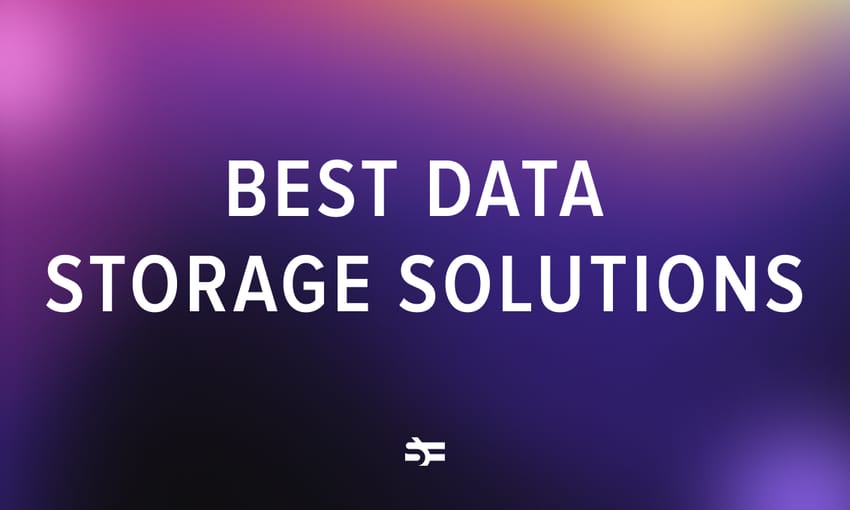Organizations are driven by people, and people thrive when they communicate effectively. Yet, poor communication stands as one of the leading causes of workplace stress and inefficiency:
- 52% of employees experience heightened stress levels due to miscommunication.
- 64% lose at least three hours of productivity each week because of poor collaboration.
- 41% of enterprise workers have either left or considered leaving their jobs due to poor collaboration.
The numbers show how crucial clear communication is for businesses, especially those with large, geographically dispersed teams.
Lack of clear communication can lead to significant issues for businesses such as project setbacks, decreased motivation, and missed chances. This is why using the correct tools that promote transparency and better team collaboration is a must for every business.
Let’s have a look at the top 10 collaboration tools that can enhance your team’s productivity.
1. Basecamp
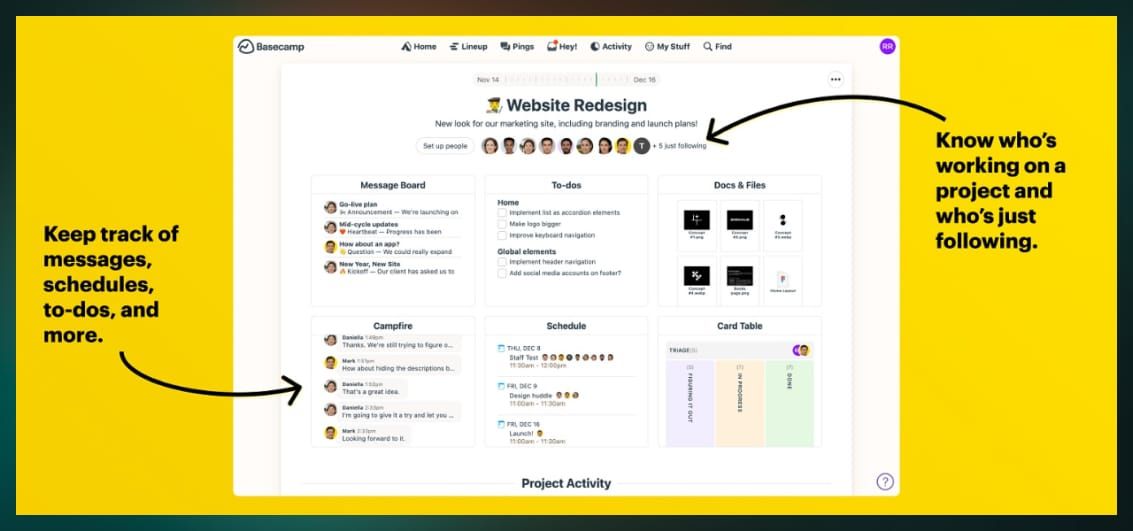
Basecamp is a project management and collaboration tool designed to simplify project tracking. It’s best known for its user-friendly interface that includes to-do lists, message boards, chats, and Kanban boards, which centralize project work and reduce the need for multiple communication tools.
This tool helps improve organizational transparency and streamline workflows. Basecamp is ideal for both small businesses and growing companies, offering unlimited users for a fixed monthly price.
Pros:
- Internal chat for focused project conversations
- Items are private by default, with customizable permissions
- Intuitive paper-stack interface
- Keyboard shortcuts for easy navigation
Cons:
- Lacks a traditional grid/list view
- No timeline view for task dependencies
- Basic reporting features reliant on client monitoring
2. Slack
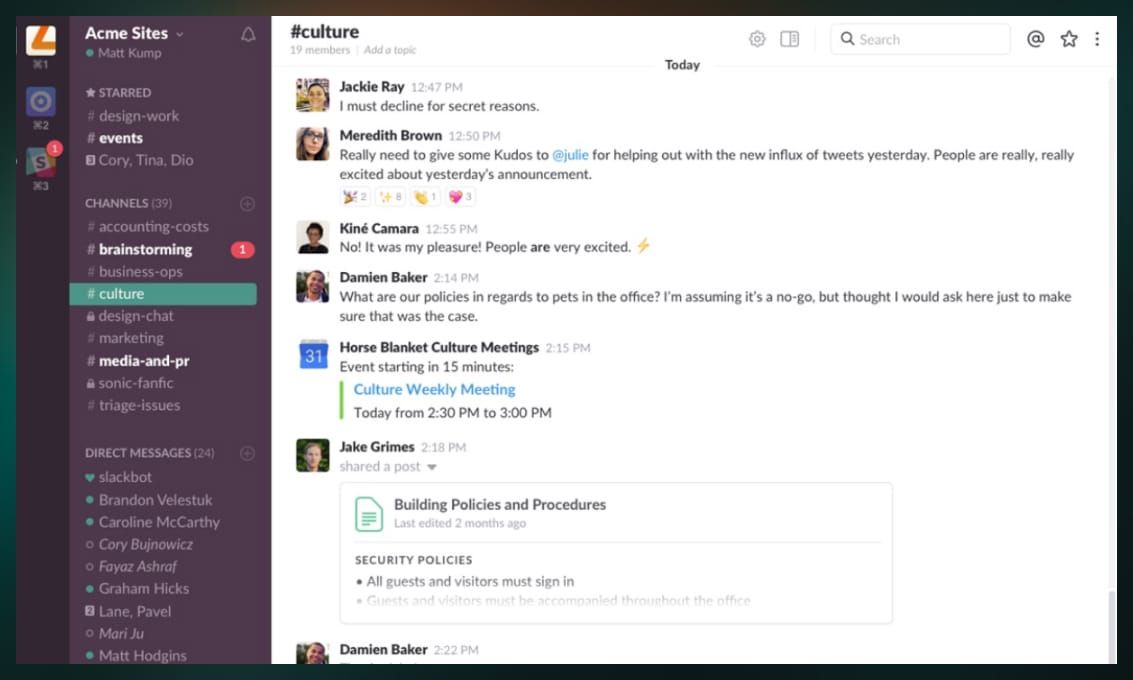
Slack does not need any introduction. It is one of the best known SaaS tools and a team chat app that excels in centralized communication for brainstorming, discussions, and collaboration. It seamlessly integrates with many business apps, enhancing its functionality.
Slack’s intuitive interface allows for easy topic-based channel creation, facilitating organized conversations. Its robust file-sharing capabilities and customizable features, such as emojis and notifications, make it a versatile tool for team collaboration.
Pros:
- Diverse communication options (voice calls, video meetings, chats)
- Channels help keep topics separated and organized
- Canvases for collaborative brainstorming and file sharing
- Highly customizable interface
Cons:
- Can become expensive compared to similar tools
- Conversations can get buried, making it hard to retrieve past discussions
3. Chanty
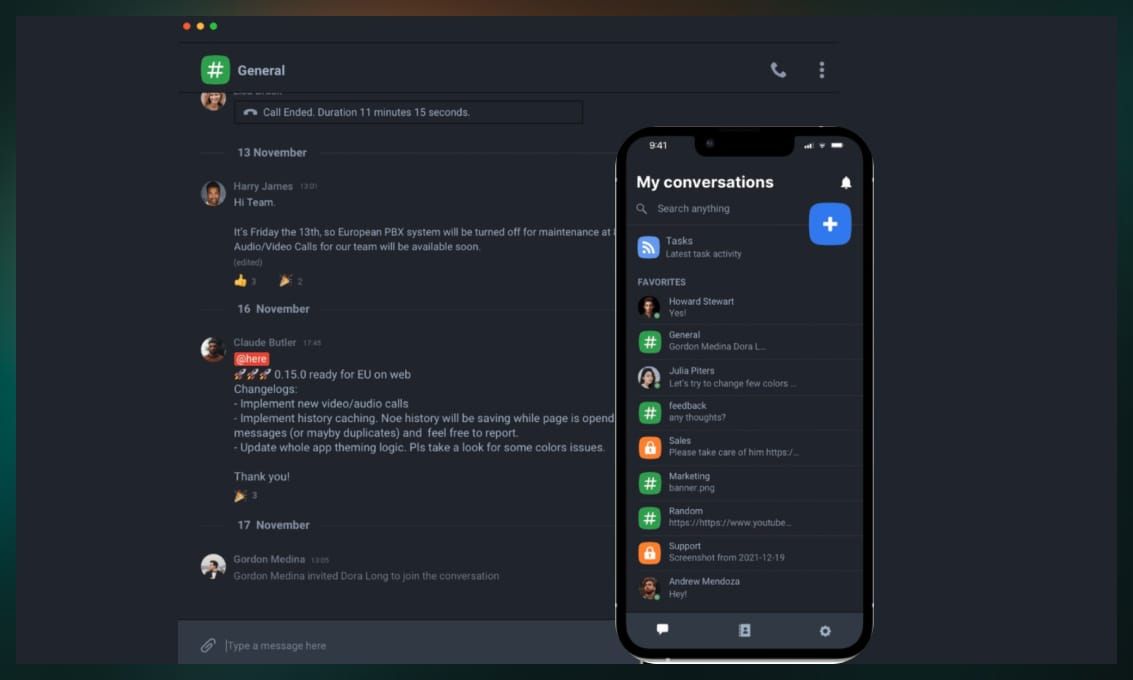
Chanty is a versatile internal communication app designed to connect both back-office and frontline staff, ensuring seamless collaboration regardless of location or device. Like WhatsApp, Chanty offers unlimited messaging, even in its free plan, along with powerful collaboration features like audio and video calls, screen sharing, and built-in project management features.
Its Teambook feature centralizes all your chats, tasks, files, and links in one place, making team coordination easy and efficient. With additional voice messaging options and robust security features like advanced role management and IP Allowlist, Chanty can be your go to tool for team collaboration.
Pros:
- Unlimited messaging in all plans
- Video and audio conferencing capabilities
- Kanban board project management
- Mentions for quick team reach and threaded conversations
Cons:
- Limited third-party integrations, with more in development
4. Zoom

Zoom is a widely used video conferencing tool known for its high-quality video and audio support, even in low-bandwidth environments. Zoom supports large groups, allowing up to 1,000 participants in a single meeting.
It offers features like screen sharing, recording, virtual backgrounds, and chat, webinars, and virtual events. Users can add people from outside their organization to their contacts and collaborate across organizations. Teams can even share and co-edit whiteboards with others.
Pros:
- Easy to use with an intuitive interface
- High-quality video and audio options
- Extensive collaboration features (screen sharing, virtual backgrounds)
- Supports large meetings with up to 1,000 participants
Cons:
- Security concerns, such as unauthorized access (“Zoom-bombing”)
- Bandwidth limitations can affect video and audio quality
5. MeetGeek
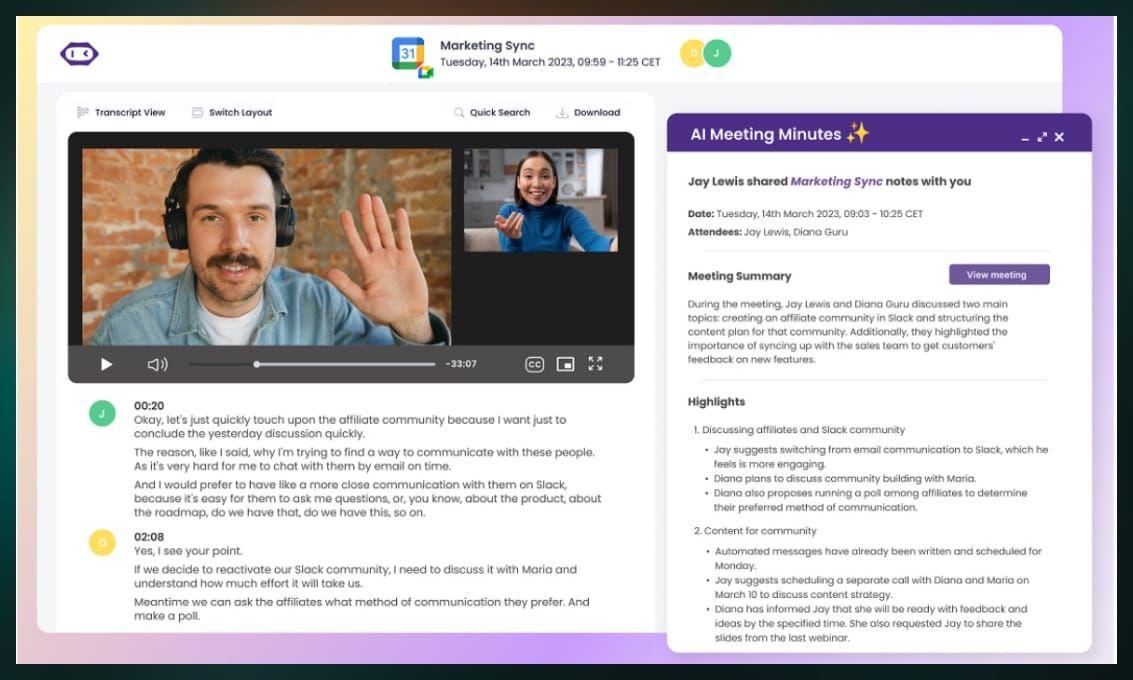
MeetGeek is an AI-powered meeting assistant designed to enhance team collaboration by automating meeting tasks. It records, transcribes, and summarizes conversations, helping teams stay organized without manual note-taking.
Key features include topic detection, conversation intelligence, and automatic summaries. MeetGeek also offers integration with tools like Slack and Notion, enabling seamless workflows and improved communication.
Pros:
- AI-powered meeting automation
- Customizable meeting templates and analytics
- Over 7,000 integrations through Zapier
- Centralization and knowledge-sharing capabilities
Cons:
- Limited free tier
- Occasional transcription inaccuracies and a learning curve for customization
6. Miro
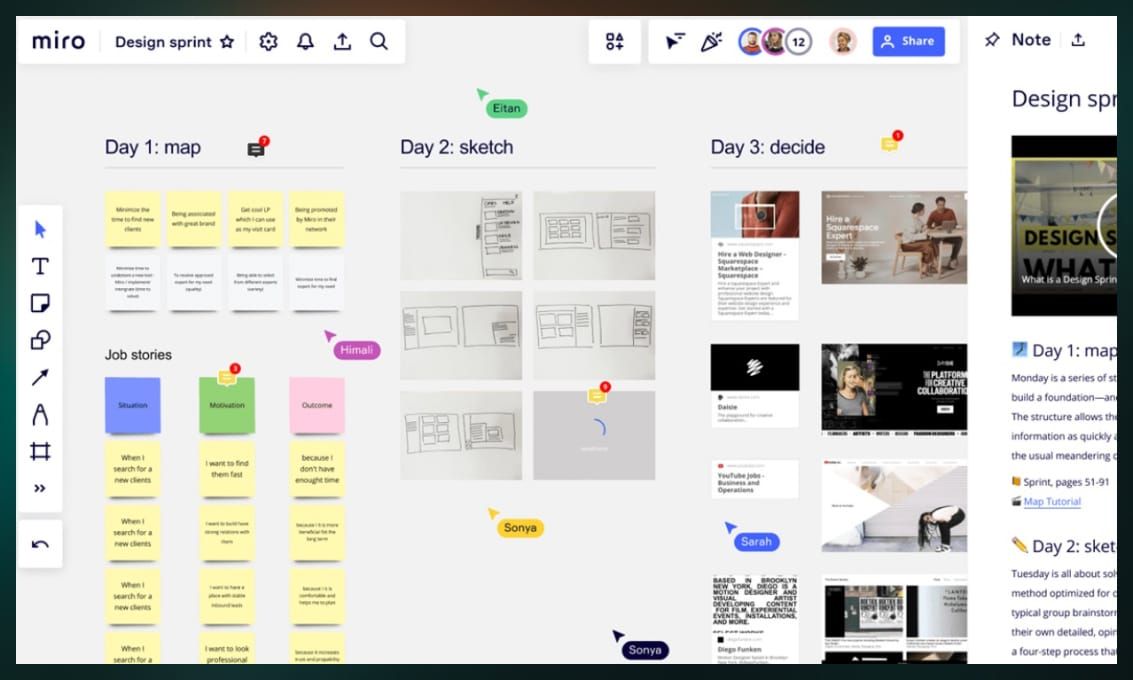
Miro stands out in the team collaboration sphere with its expansive digital canvas that excels in visual brainstorming and idea mapping. Its intuitive drag-and-drop interface, coupled with a variety of pre-built templates, makes it a go-to tool for visually oriented teams.
Miro’s real-time collaboration features enable team members to brainstorm, plan, and work seamlessly, even from different locations. Teams can collaborate on mind maps, wireframes, and flowcharts all in one place.
Pros:
- Versatile for whiteboarding, mind mapping, and brainstorming
- User-friendly interface
- Strong real-time collaboration features
- Extensive integrations (Google, Microsoft)
Cons:
- Sometimes performance issues (crashes and freezes)
- Limited offline access
7. Google Workspace
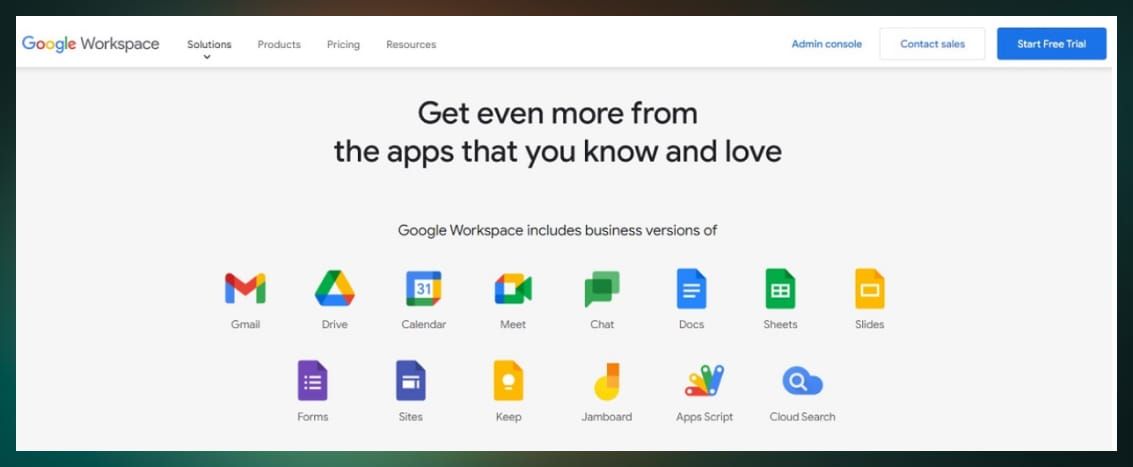
Google Workspace, formerly G Suite, offers an all-in-one suite of apps for seamless team collaboration and communication. Known for its real-time co-editing in Docs, Sheets, and Slides, it’s ideal for remote and hybrid teams. Its cloud-based nature allows easy file access, sharing, and collaboration from anywhere.
Google Meet provides virtual meetings, while Gmail and Calendar keep communication streamlined. Workspace excels in integrations across Google tools, but some users find it less powerful compared to desktop alternatives, and customer support may be lacking.
Pros:
- Seamless integration of Google tools
- Real-time collaboration
- User-friendly and mobile-accessible
- Effective spam protection in Gmail
Cons:
- Limited features compared to desktop apps
- Issues with customer support
8. Pont

Pont helps remote teams work better together by putting everything in one place. Instead of switching between different tools, Pont brings all your time tracking, communication, and project management information together. You can easily see what your team is working on, track progress, and manage tasks from one simple dashboard.
It connects with popular tools like Slack, Google, GitLab, GitHub, and Jira, so you don’t need to change what you’re already using. Pont’s easy-to-use interface shows all the important tasks and updates, helping teams stay organized and productive.
Pros:
- Combines all tools in one place
- Seamless integration with popular software (Slack, Jira, GitHub, etc.)
- User-friendly interface simplifies workflow management
Con:
- Limited customization options for unique team setups
9. Notion
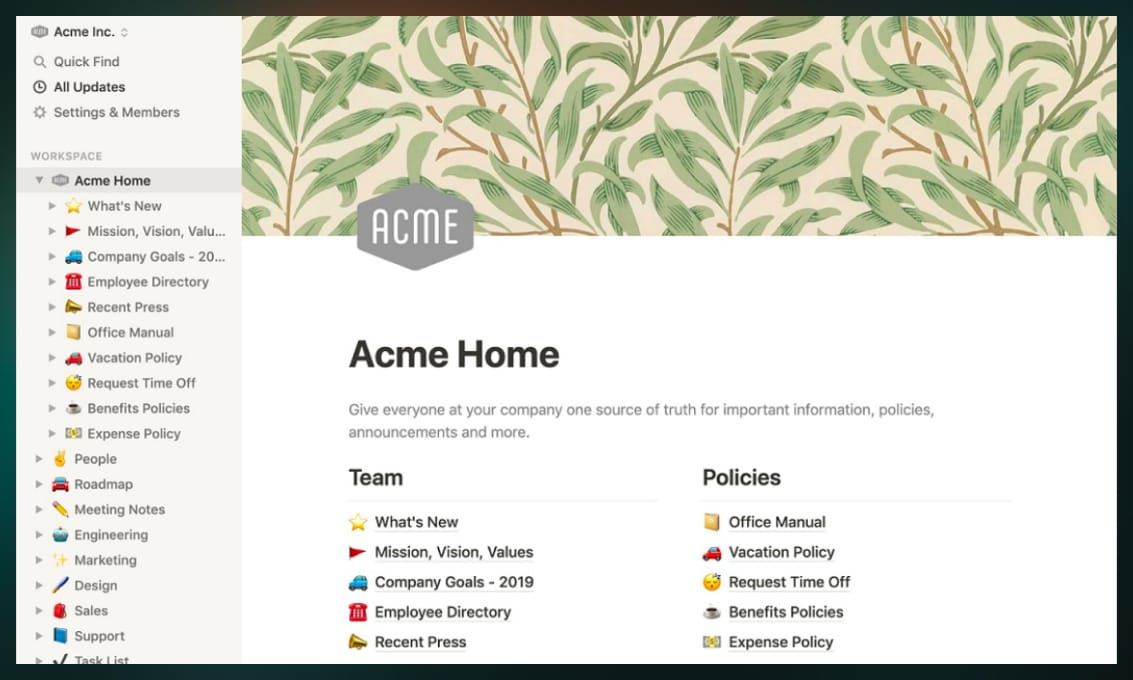
Notion offers a flexible and all-in-one workspace for teams to collaborate in real-time and asynchronously. It’s perfect for organizing everything from documents and spreadsheets to project boards and to-do lists, with all content stored in one central location.
Its real-time updates and the ability to assign tasks ensure smooth collaboration across teams. Users can leave comments, track changes, and set customizable notifications, helping teams stay on the same page. However, Notion lacks offline functionality, making it less reliable without internet access.
Pros:
- Elegant interface for seamless collaboration
- Real-time updates with excellent revision tracking
- Works consistently across browsers
- Corporate-friendly user management
Cons:
- Online-only apps
- Limited offline editing capabilities
10. Internxt
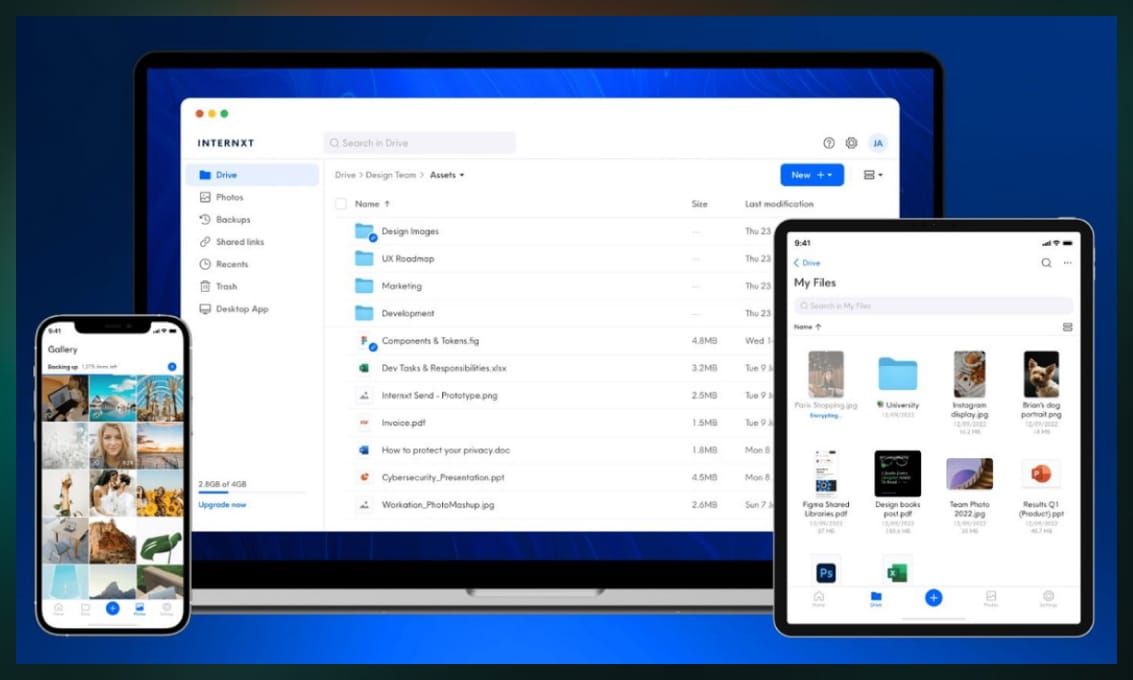
Internxt is a privacy-focused cloud storage solution designed to keep your files secure through zero-knowledge encryption. It offers plans for individuals, families, and businesses, with tools like Internxt Drive for cloud storage and Internxt Send for encrypted file transfers.
With strong encryption and open-source technology, Internxt guarantees that even they cannot access your files. While it excels in security, it lacks real-time document collaboration features.
Pros:
- Offers 1GB of free storage
- Strong focus on privacy with zero-knowledge encryption
- Affordable plans with free storage options
- Available on multiple platforms (Windows, Mac, Linux)
- Comes with free additional tools like a VPN and file converter
Cons:
- No real-time collaboration on documents
Aiming for better team collaboration and productivity
Open communication helps team members share ideas, solve problems, and stay connected. Hence, with the right approach and productivity tools, teams can work more smoothly and get more done.
Start with using easy-to-use collaboration tools that combine messaging, project management, and file sharing to keep everyone on the same page.
Setting clear goals and tracking progress also helps teams stay focused and accountable. Keep encouraging feedback and flexibility, allowing your teams to adjust and improve how they work together.
About the author
Vishal Narsale is a Content Marketer at Growthbuzz Media & Make SaaS Better as well as an SEO enthusiast. He helps fast-paced B2B SaaS startups acquire customers through organic marketing efforts.





.jpg)
.jpg)
